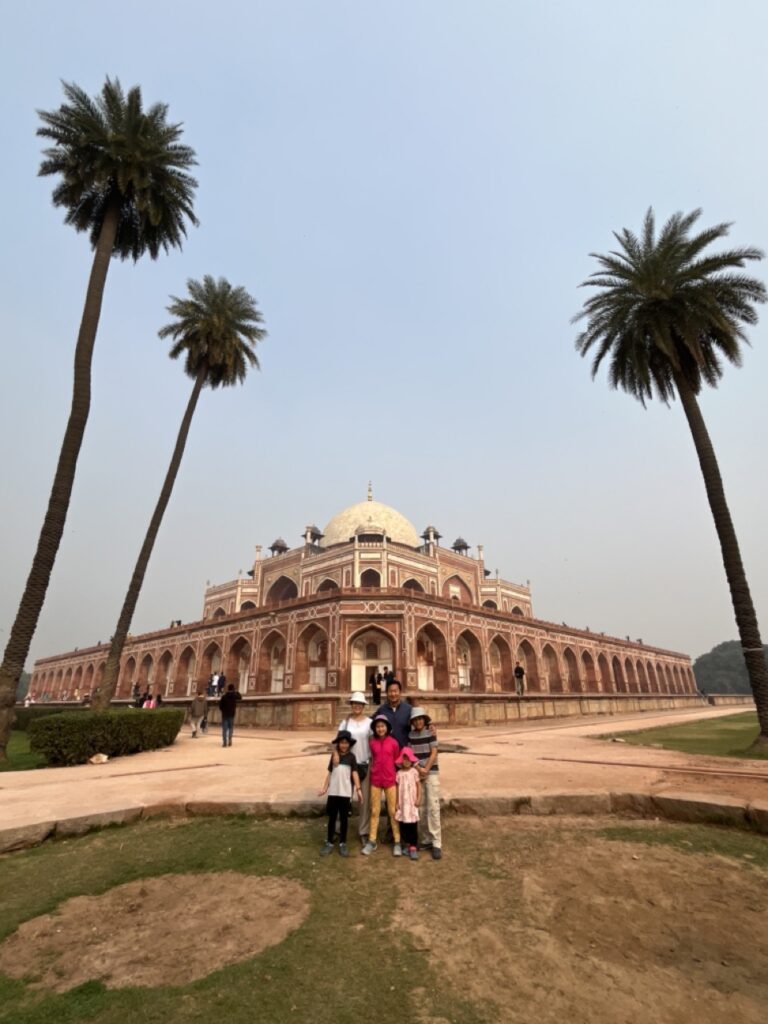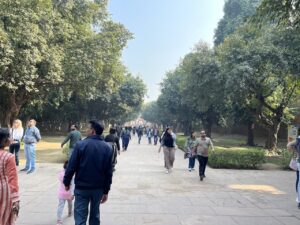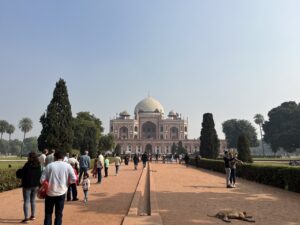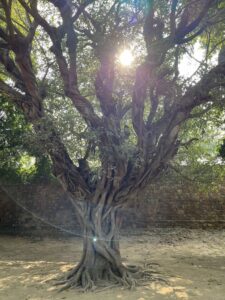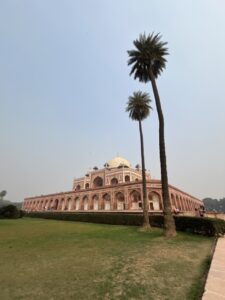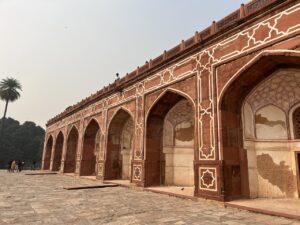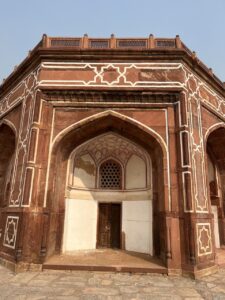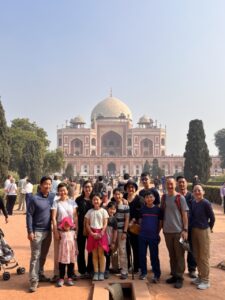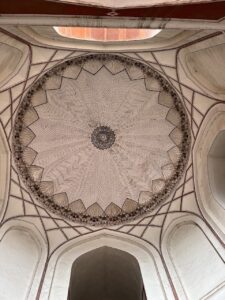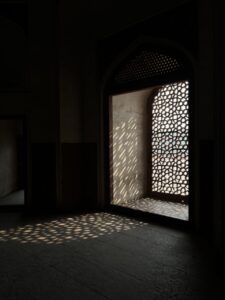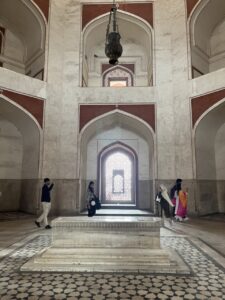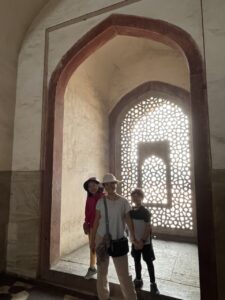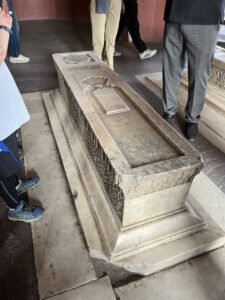The Mughals ruled India for nearly 300 years from 1526 to the middle of the 19th century. The height of the empire lasted under 200 years until it was in a state of decline before the British arrived. The Mughals were from Central Asia – Turkey and Persia. The main language of the Mughals was Persian and they were Muslim. The founder of the Mughals was called Babur, a prince from the Timur dynasty in what is now Uzbekistan, and a direct descendant of Genghis Khan.
Humayun was the second Mughal Emperor of India. The tomb of Humayun was built by his widow and son, the Emperor Akbar, in the 1560’s. They chose the location because there once stood the shrine of a 14th century Sufi saint. Humayun’s tomb complex came to be known as the necropolis of the Mughal dynasty because over 150 Mughal rulers and their family members were eventually buried at the site.
Many of the grand buildings, tombs and forts in India date back to the Mughal period. Mughal architecture is beautiful and easy to identify in India. It blends Islamic and Indian design and aesthetics, resulting in some of the most famous and recognizable structures in the world. Key Mughal architecture features include architectural symmetry, bulbous domes, vaulted archways, slender minarets, detailed ornamentation and intricate carvings. The favored building materials of the Mughals was marble and sandstone.
Flowing water was another feature of Mughal architecture. At the entrance of the grounds, we were met with a pond and a water channel that was probably once filled with flowing water. There are four water channels flowing from each of the four cardinal directions. I could imagine how grand the gardens and tomb would have looked if all of the water features were working. I did take note of the still pond at the entrance that looked murky and disgusting, not grand at all.
We entered the garden area of Humayun’s tomb and Rajesh guided us to a shaded area to answer an earlier question somebody had about Buddhism. We sat under a canopy of trees and listened to the story of Siddhartha’s transformation from a Hindu prince who renounced his status and worldly possessions into the Buddha and in preaching his path to enlightenment, founded Buddhism.
As we got closer to the mausoleum, we could see how beautiful and impressive the structure was. The mausoleum is architecturally significant because it is the first grand mausoleum of the Mughal dynasty that culminated in its penultimate expression, 80 years later, in the construction of the Taj Mahal. Persian and Indian craftsmen worked together to build the first-of-its-kind tomb that outshined any that had ever been built in the Islamic world at the time. The mausoleum is constructed of red sandstone with white and black marble inlay.
Inside the mausoleum, we found several rooms with marble coffins intricately carved with decorations and writing. We were told they belonged to Humayun’s wives and family members. Everywhere we looked, there was intricate craftsmanship in the form of carvings and inlay. The light shining through the lattice windows lent a somber and contemplative mood to the chamber.
Ready to go, we walked along the long path through the gardens back in the same direction that we came in. The kids were busy chatting with their uncles, aunts and cousins. It was hard to keep track of where they all were. As we approached the main gate, from the corner of my eye, I saw DY step backwards into the putrid pool of stagnant water that I had noticed when we first arrived. In my memory, I had even reminded the kids to walk carefully so as not to trip into the stinky water. But did I? It didn’t matter anyway. Luckily, the water was not deep, reaching only up to around his knees. Luckily, he did not trip and face plant into the water. Luckily, it was just his legs.
I ran back toward DY and grabbed his hand to stabilize him as he high-stepped out of the pond. There was a little crowd forming to watch the events unfold. Hand in hand, we rushed to the ladies bathroom. I did not know what was in the stinky pond and how dirty it was, but I knew I needed to wash off his legs and rinse out his clothes. The bathroom was not the cleanest, but we managed to find a ledge for DY to sit. I peeled off his soaking pants, socks and water-logged shoes. Luckily, he was wearing leggings under a pair of quick-dry shorts otherwise we would have had to weigh modesty against hygiene. I rinsed off his legs and washed the other stuff in the sink as best as I could. I put the wet shorts back on him and because his shoes were soaked through, I piggy-backed him to find Leo. All the while, he was apologizing profusely for causing me so much trouble.
It seemed like just yesterday that I carried DY in an Ergo on my back for hours as we toured Angkor Watt under the relentless sun. Time plays tricks on us because it was actually before Covid, four years ago. Now, I could barely manage to carry him a few hundred meters and I stumbled beneath the weight of my seven year-old son. If it was dark, our conjoined shadow probably looked like that of a two-headed, four-armed beast leaving a trail of icky wet stuff. I found Leo who by then had heard about what happened and was looking for us too. Leo carried him the rest of the way to our tour bus. I felt my back and waistband and they were soaked from DY’s wet shorts.
After lunch, while the rest of the group went to visit the Qutub Minar, I caught an Uber back to the hotel with DY and EY. DY’s shoes were still soaked so it would have been uncomfortable for him to walk.
One day, the kids won’t need or want me to pull them out of the stinky water and tell them everything is ok. One day, they’ll be able to do it themselves. Until that day arrives, you can count on me to savor the moments – good and bad, smooth and rough, joyful and frustrating, that we have together.
Author
-

Song is the mother of four children. She and her family have stepped away from it all and in September 2023, began traveling the world while homeschooling. Song is an ABC (American born Chinese) and has an undergraduate degree from Cornell and an MBA from Harvard. She is an entrepreneur and an educator. Her hobbies include learning, traveling, reading, cooking and baking, and being with children.

